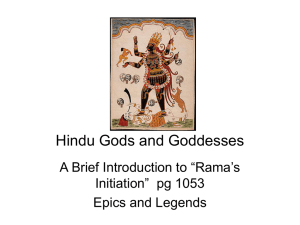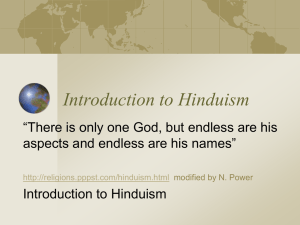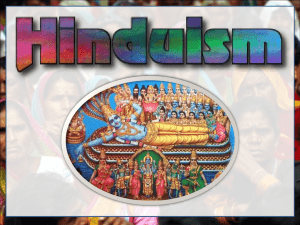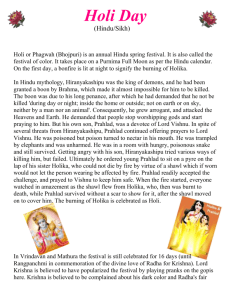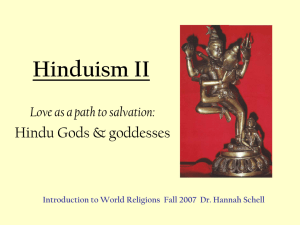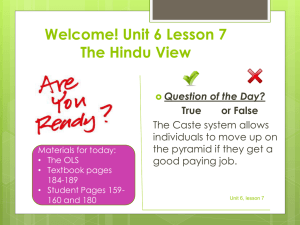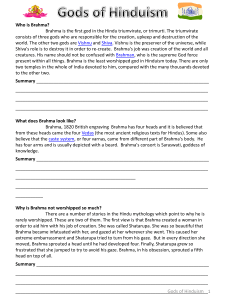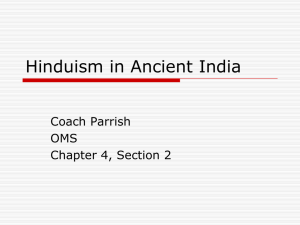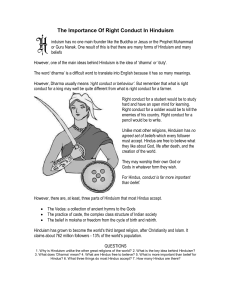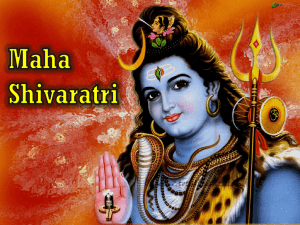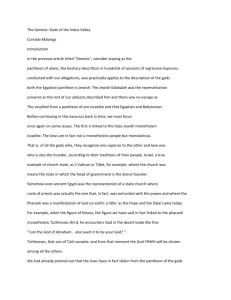a hindu pantheon - KSU Web Home
advertisement
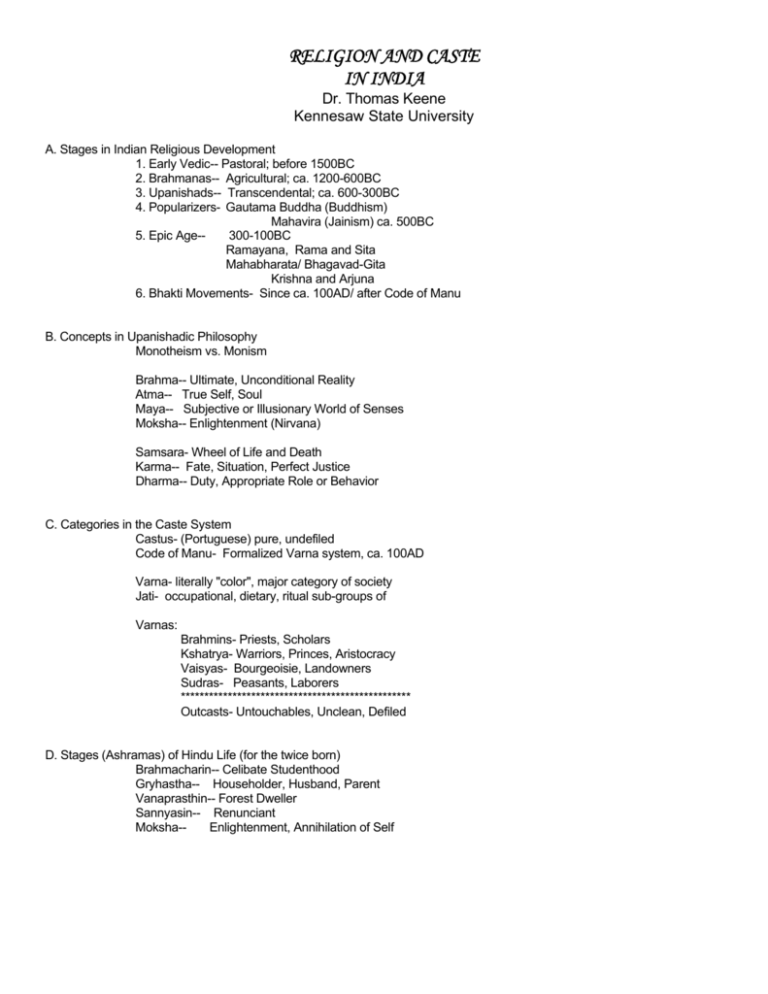
RELIGION AND CASTE IN INDIA Dr. Thomas Keene Kennesaw State University A. Stages in Indian Religious Development 1. Early Vedic-- Pastoral; before 1500BC 2. Brahmanas-- Agricultural; ca. 1200-600BC 3. Upanishads-- Transcendental; ca. 600-300BC 4. Popularizers- Gautama Buddha (Buddhism) Mahavira (Jainism) ca. 500BC 5. Epic Age-300-100BC Ramayana, Rama and Sita Mahabharata/ Bhagavad-Gita Krishna and Arjuna 6. Bhakti Movements- Since ca. 100AD/ after Code of Manu B. Concepts in Upanishadic Philosophy Monotheism vs. Monism Brahma-- Ultimate, Unconditional Reality Atma-- True Self, Soul Maya-- Subjective or Illusionary World of Senses Moksha-- Enlightenment (Nirvana) Samsara- Wheel of Life and Death Karma-- Fate, Situation, Perfect Justice Dharma-- Duty, Appropriate Role or Behavior C. Categories in the Caste System Castus- (Portuguese) pure, undefiled Code of Manu- Formalized Varna system, ca. 100AD Varna- literally "color", major category of society Jati- occupational, dietary, ritual sub-groups of Varnas: Brahmins- Priests, Scholars Kshatrya- Warriors, Princes, Aristocracy Vaisyas- Bourgeoisie, Landowners Sudras- Peasants, Laborers ************************************************* Outcasts- Untouchables, Unclean, Defiled D. Stages (Ashramas) of Hindu Life (for the twice born) Brahmacharin-- Celibate Studenthood Gryhastha-- Householder, Husband, Parent Vanaprasthin-- Forest Dweller Sannyasin-- Renunciant Moksha-Enlightenment, Annihilation of Self A Hindu Pantheon Among the remarkable achievements of Hinduism was its blending of the countless cults, gods, and totems of India’s many ages and diverse peoples into one vast mythology—a mythology dominated by the two Hindu gods, Shiva and Vishnu. The roster of these deities reaches, quite literally, into the millions. It includes all the gods of early sacred and epic literature and their later permutations; deified mortals; and the animals, birds, trees mountains, rivers, and plants revered as divine personalities by India’s primitive tribes. The characteristics of many of these gods often merged into one. Shiva, for example, incorporates aspects of the fertility-god of the prehistoric Indus Valley people, as well as the fierce god Rudra of the early Aryan invaders and the unnamed dance-gods of the Dravidians of the Tamil region. When such adopted gods were too disparate to be combined, they were simply made members of the family of important gods or incarnations (avatars) of them. Animals venerated by the earliest Indian societies—the bull, the elephant, the serpent—were joined to the Hindu pantheon as companions of the major deities. A few of the best-known and most widely worshipped of these deities, avatars, and companions are noted below. BRAHMA THE CREATOR. Once thought the greatest of the gods because he sets the universe in motion, Brahma faded in importance with the rise of Shiva and Vishnu. He appears in while robes and rides a goose. From his four heads sprang the Vedas, which he carries along with a scepter and various other symbols. SHIVA THE DESTROYER. One of Hinduism’s two mightiest gods, Shiva represents power in all ramifications— the fierce ascetic; the demon-slayer entwined in snakes and wearing a headdress of skulls; the Lord of Creation, dancing in a circle of fire; the male symbol of fertility. He, more than other gods, is a composite of older gods, cults, and myths reaching back to India’s prehistory. PARVATI (or MAHADEVI), Shiva’s wife, was the daughter of the Himalaya Mountains and the sister of River Ganges. With love, she lured Shiva from asceticism; she represents the unity of god and goddess, man and woman. UMA is the golden goddess, a creature of light and beauty who, as a form of Parvati, reflects milder manifestations of her husband, Shiva. She sometimes mediates conflicts between Brahma and the other gods. DURGA is Parvati as a ferocious, 10-armed goddess. She sprang full grown from the flaming mouth of Brahma, Shiva, and Vishnu. Astride a tiger, she uses the weapons of the gods to battle demons. KALI is Parvati turned into Hinduism’s most terrible goddess, with an insatiable lust for blood sacrifice. She usually appears blood-smeared, bedecked in snakes and wearing a necklace of her son’s skulls. THE BULL NANDI, sacred to the Indus people as a fertility symbol, was absorbed into Hinduism as Shiva’s constant companion—his mount, his chamberlain, his musician. Shiva wears Nandi’s emblem, the crescent moon, on his brow. KARTTIKEYA (or SKANDA) replaces the Vedic god Indra as the principal Hindu god of battle. The son of Shiva and, in some myths, begotten without a mother, he is interested only in fighting and war. Six-headed and 12-armed, Karttikeya leads his celestial legions from the back of a colorful peacock. GANASHA. The elephant-headed son of Shiva, is probably the most popular god in the pantheon. Wise, thoughtful and well versed in the scriptures, he is invoked by worshippers before every undertaking to assure success. VISHNU THE PRESERVER. To many Hindus, Vishnu is the Universal God—usually holds four symbols: a discuss, a couch shell, a mace, and a lotus. Whenever mankind needs help, this benevolent god appears on earth as an avatar, or reincarnation. It is generally believed that nine avatars have already appeared, a tenth is yet to come. Some feats of avatars reflect Indian history. THE HORNED FISH MATSYA represents Vishnu’s intercession at a time of universal flood. The fish warned Manu (the Hindu equivalent of both Adam and Noah), then saved him in a ship hooked onto his horn. THE TORTOISE KURMA, the second avatar of Vishnu, appeared on earth after the flood to retrieve treasures, including the ambrosia of the gods. The tortoise churned the ocean, bringing up the ambrosia. THE BOAR VARAHA, originally the sacred pig of a primitive cult, became an avatar of Vishnu after a second flood. Digging underwater with his tusks, the boar raised the earth and restored it to dry land. THE MAN-LION NARASIMHA was another avatar of Vishnu. Brahma had given a demon invulnerability day and night against god, man or beast. The avatar—god, man, and beast—killed the demon at dusk. THE DWARF VAMANA, another avatar, became a giant to foil demon who sought control of the universe. Granted permission to keep all he could cover in three steps, Vamana encompassed the earth, sky and middle air. PARASURAMA was Vishnu as the son of a brahman robed in a kshastriya king. Parasurama killed the king, whose sons in turn killed the brahman. Parasurama then killed all male kshastriyas for 27 generations. RAMA, the hero of India’s great religious literary epic, The Ramayana, was Vishnu as an avatar who overcame the world’s most terrible demon, Ravana. Rama represents the ideal Hindu: a gentle husband, a kindly king and, most significantly, a leader valiant under oppression. SITA, Rama’s wife, an incarnation of Lakshmi, represents the ideal Hindu wife. She was abducted by the demon Ravana and taken to his abode, but devoted to her husband. HANUMAN, the monkey king, lent agility, speed and strength to Rama to help free Sita from Ravana. In return, he asked to live as long as men remember Rama; thus, Hanuman is immortal. KRISHNA, Vishnu’s most important avatar, was a hero-god beloved in many aspects: a prankish chiuld, an amorous adolescent, a mature hero who spoke the great lessons of the Bhagavad Gita. These aspects of Krishna had different origins: Aryan, Dravidian, perhaps Christian. BUDDHA, as an incarnation of Vishnu, exemplifies Hinduism’s ability to absorb disparate religious elements. The avatar Buddha appeared, Hindus say, primarily to teach the world to have compassion for animals. KALKIN, the avatar of Vishnu yet to come, is pictured on a white horse, punishing evil-doer and rewarding the righteous. Some Hindus look to his arrival as some Christians do to Christ’s Second Coming. LAKSHMI, Vishnu’s wife, often shown both sitting on a lotus and holding a lotus, represents good fortune. Her attendants are two gentle elephants. An important goddess in her own right, she is also worshipped as the avatar Sita. GARUDA, Vishnu’s mount, is a mythical white-faced bird with the head and wings of an eagle and the body and limbs of a man. Carrying the god on his flashing golden back, he was sometimes mistaken for the fire-god, Agni.
